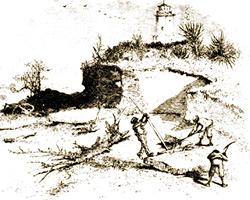Coquina: Florida's Native Stone
This native sedimentary rock was used in the construction of nearly every East Florida plantation and sugar mill. Coquina is soft and easy to cut in the ground, but it hardens when exposed to the open air, making the stone suitable for building.

Coquina rock is the product of sedimentary formations that underlie much of Florida's Atlantic shore. Coquina is a mixture of shell fragments and quartz grains held together by calcium carbonate that formed when higher sea levels covered our present coast. Coquina means "tiny shell" in Spanish. The name also was given to the small clam, Donaxvariabilis, whose shells provided the natural aggregate for Coquina rock. Anastasia Island was called "Cantera" - Spanish for quarry - in St. Augustine, because it was a rich source of superior Coquina rock. Large-scale quarrying began under Spanish rule in 1671 for the construction of the Castillo de San Marcos in St. Augustine.
Coquina has been used extensively in Florida for over four centuries. It was used in many colonial buildings, most of which were built with slave labor under the supervision of master masons. The historic coquina masonry work of Florida is considered exceptional for the quality of its workmanship.

